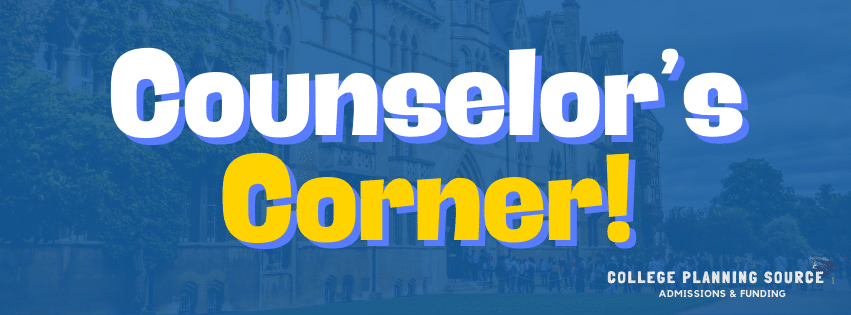-
Counselor's Corner
- Course Selection- What You Need to Know
- Take Advantage of Your Summer
- College Spotlight: Fordham University
- Committing to a College- The Final Step
- Comparing the New Digital SAT to the ACT
- Demonstrating Interest In a College
- Summer Options: Taking Community College Classes
- Summer Program Spotlight - EPIC @ Cal Poly SLO
- College Tours and Visits - Questions to Ask and What to Look for
- How to Create a Balanced College List
- The Pre-College Application(s) Checklist
- College Spotlight: University of Wisconsin
- Understanding Early Action, Early Decision, and Restrictive Early Action: Making the Right Choice
- Preliminary SAT (PSAT)/ National Merit Scholarship Qualifying Test (NMSQT)
- October Checklist for Success - Seniors & Underclassmen
- Researching Colleges: Tools to use to learn more about each college on your list.
- 13 Ways We Can Detect AI in College Essays
- Common words used in AI-generated college admission essays
- 8 ways to approach leveraging AI in the essay writing process while keeping it authentic to you
- Understanding the Benefits of Summer Programs: Find Your Passion and Elevate Your College Applications
- Show all articles (5) Collapse Articles

Researching Colleges: Tools to use to learn more about each college on your list.
By Karen Rowe
As a college counselor, I often ask students if they have researched a college. The usual response is, “Yes, I looked at the website.” While that is a solid starting point, a college website offers limited insights. I recommend digging deeper with these tools to get a fuller picture of a college’s vibe, admissions data, cost of attendance, and acceptance outlooks per major.
Fiske Guide: This resource was first published in 1982 by Edward B. Fiske, a former education editor for The New York Times. It focuses on the personality or vibe of a college. Students will get a glimpse into things like social life, whether it is a collaborative academic environment or cutthroat, whether it is easy to build relationships with the professor, and even whether the food is tasty. It also provides “Overlap Schools”, so if you like what you are reading, you can find similar institutions to possibly add to your college list. The Fiske Guide is a book you can find on Amazon, and it can be found in your Custom College Plan Account in the Colleges Tab.
Common Data Set: This tool is ideal if you like numbers and facts when evaluating a college. By Googling “ Common Data Set – name of college” you will find a PDF report of admissions statistics. Examples of what you will find on the Common Data Set include the number of students who applied, were accepted, and enrolled, what factors are highly considered in an application, average GPAs and test scores, as well as their Early Action and Waitlist data.
Net Price Calculator: If you are curious about what the cost of attendance would be at a college on your list, use this handy tool to enter financial information. By Googling “Net Price Calculator- name of college,” you will be able to find what a predicted cost of attendance would be at each instituion in order to make an informed decision about applying.
UC-Specific Major Data: You have heard that the UCs are competitive, but learning just how competitive each major is can be eye-opening. Use this link to reveal the acceptance rates of majors at each of the UCs.
Speak with your college counselor about using these tools as you build your college list together. The more informed you are about your choices, the more successful you will be in your college journey.

